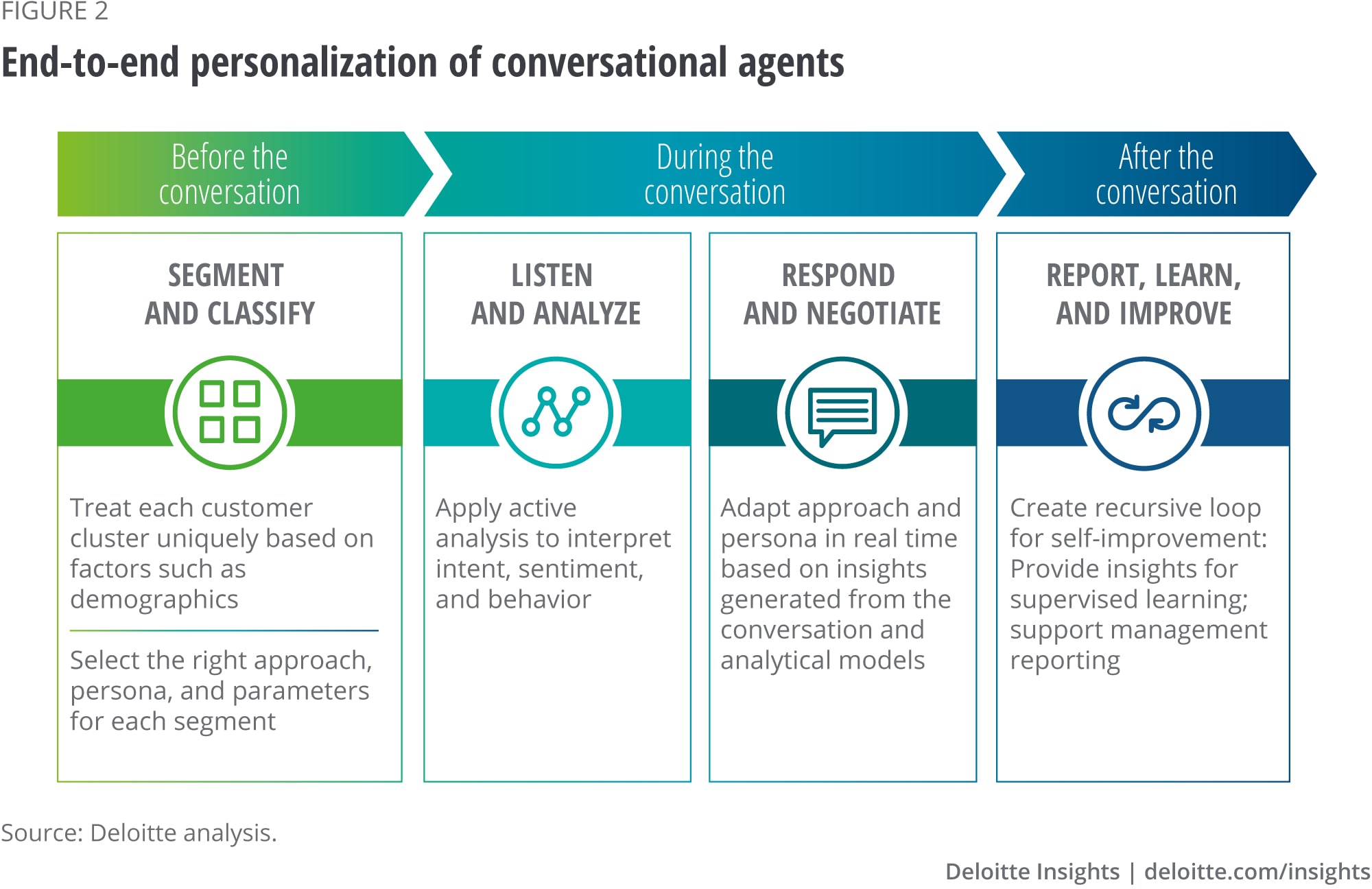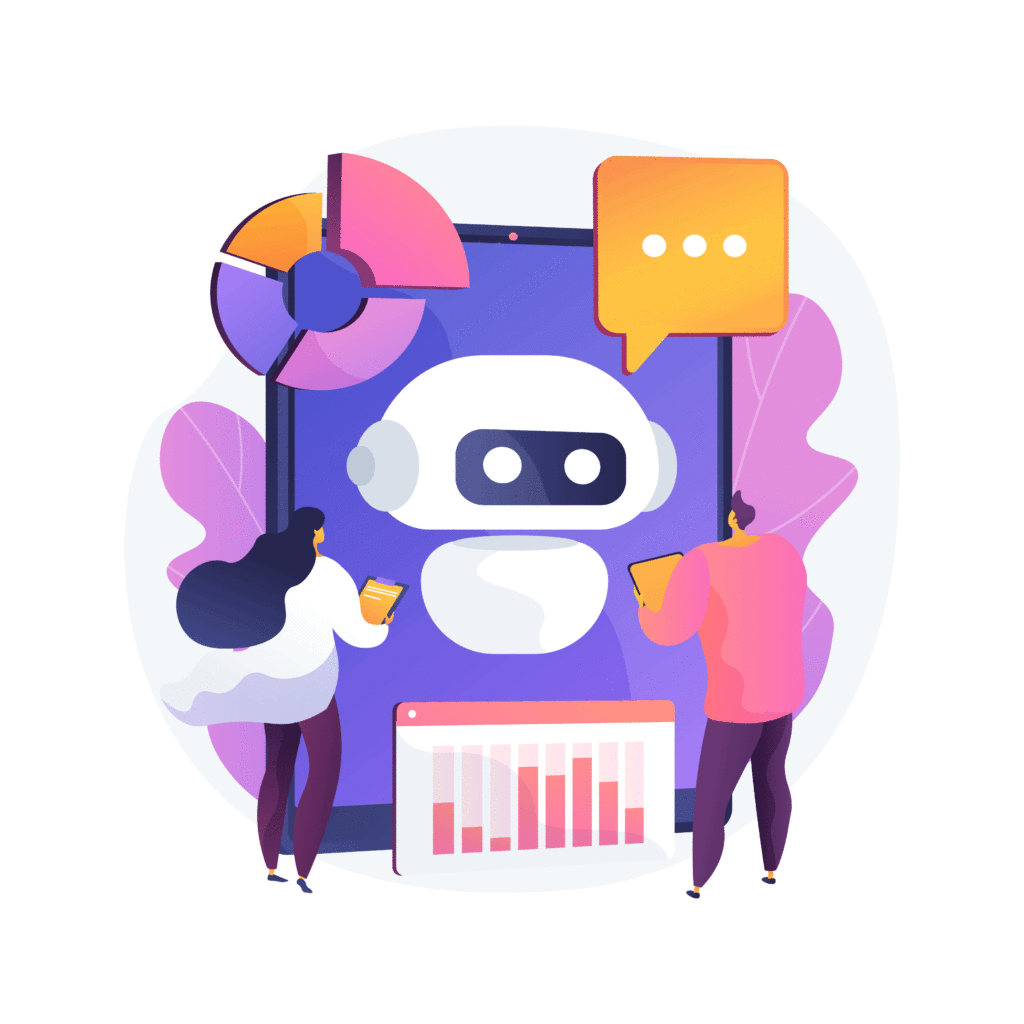The Rise of Conversational Agents: Should You Be Concerned?

A conversational agent (e.g. chatbot) may seem like something from a Sci-Fi movie, but we are using them more and more everyday. Imagine a world where you could have a friendly and helpful conversation with a computer program. Well, that world is now becoming a reality with the rise of conversational agents.
These innovative and intelligent programs are designed to simulate human-like conversations, providing assistance, information, and even entertainment. As the demand for seamless and personalized interactions grows, conversational agents are quickly becoming an integral part of our daily lives, serving as virtual companions and remarkable problem solvers.
With their ability to understand context, empathize, and adapt to different conversational styles, these conversational agents are changing the way we interact with technology, making our lives easier and more enjoyable.
Table of Contents
The Rise of Conversational Agents
Conversational agents, also known as chatbots, virtual assistants, or voice assistants, have become increasingly popular in recent years. These interactive software programs are designed to simulate human conversation, allowing users to interact with them through natural language. Conversational agents have evolved significantly and are now being implemented in various industries, offering a wide range of benefits and applications.

Definition of Conversational Agents
Conversational agents can be defined as computer programs or artificial intelligence systems that are capable of engaging in conversation with human users. They are designed to understand natural language inputs and provide relevant responses. These agents aim to mimic human conversation by using algorithms and machine learning techniques to understand user intent and generate appropriate replies. With advancements in natural language processing (NLP) and machine learning, conversational agents have become more sophisticated and capable of engaging in intelligent conversations.
The Evolution of Conversational Agents
Conversational agents have come a long way since their inception. In the early days, they were simple rule-based systems that could only respond to a limited set of predefined queries. As technology progressed, chatbots began to incorporate more advanced techniques, such as machine learning and artificial intelligence. This allowed them to understand and respond to a wider range of user inputs and self-learn from interactions. Today, conversational agents utilize cutting-edge NLP algorithms and deep learning models to provide more accurate and context-aware responses. They have become more conversational, personalized, and capable of understanding complex user queries.

Key Components of Conversational Agents
Conversational agents consist of several key components that enable them to function effectively:
Natural Language Processing (NLP)
NLP is the backbone of conversational agents. It involves the ability to understand and interpret human language. NLP techniques allow these agents to analyze and process natural language inputs, extract meaning and intent, and generate appropriate responses. Through NLP, conversational agents can understand and respond to a wide range of user queries, making them more human-like in their interactions.
Machine Learning
Machine learning plays a crucial role in the development of conversational agents. By utilizing machine learning algorithms, these agents can learn from past interactions and continuously improve their performance. Machine learning enables conversational agents to adapt to different contexts, handle variations in user inputs, and provide more personalized responses based on user preferences. It allows them to constantly enhance their understanding and conversational skills.
Dialog Management
Dialog management is responsible for managing the flow and structure of the conversation between the user and the conversational agent. It ensures that the conversation remains coherent and follows a logical sequence. Dialog management enables conversational agents to keep track of the context, manage multiple turns in a conversation, and generate appropriate responses based on the user’s previous inputs. It allows for a smooth and natural conversation between the user and the agent.
Benefits of Conversational Agents
Conversational agents offer numerous benefits to both individuals and businesses. Some of the key advantages include:
Improved Customer Service
One of the main benefits of conversational agents is their ability to enhance customer service. They can handle a large volume of customer queries simultaneously, providing immediate support and resolving issues in real-time. Conversational agents are available 24/7, reducing the need for human customer service agents and ensuring round-the-clock support. They can provide accurate and consistent information, reducing human errors and improving customer satisfaction.
Increased Efficiency and Productivity
Conversational agents can automate routine tasks and processes, saving time and increasing overall efficiency. They can handle repetitive queries, perform simple transactions, and provide information without human intervention. This allows businesses to streamline their operations and allocate resources to more complex and value-added tasks. Conversational agents can also assist employees in finding information, scheduling tasks, and managing workflows, further enhancing productivity.
Personalization and Customization
Conversational agents can personalize interactions based on user preferences, history, and demographics. They can tailor responses and recommendations to meet individual needs, creating a personalized user experience. By analyzing user data and behavior, conversational agents can understand preferences, make relevant suggestions, and provide targeted recommendations. This level of personalization enhances customer satisfaction and engagement, leading to increased loyalty and retention.

Applications of Conversational Agents in Business
Conversational agents have found widespread applications in various industries and sectors. Some of the notable applications include:
Customer Support and Assistance
Conversational agents are widely used in customer support and assistance. They can handle customer queries, provide product information, assist with troubleshooting, and guide users through various processes. These agents can significantly reduce the workload on customer service teams, allowing them to focus on more complex issues. Conversational agents can also provide support in multiple languages, ensuring efficient communication with customers from different regions.
E-commerce and Sales
Conversational agents are increasingly being used in e-commerce and sales. They can assist users in finding products, providing recommendations, and completing transactions. These agents can engage customers in personalized conversations, understand their preferences, and offer tailored suggestions. Conversational agents can also provide real-time support during the purchasing process, answering questions and addressing concerns. This improves the overall customer experience and increases conversion rates.
Knowledge Management
Conversational agents can be utilized in knowledge management systems. They can search and retrieve information from vast knowledge bases, enabling users to access relevant information quickly. These agents can provide accurate and up-to-date information on various topics, reducing the time and effort required to find specific information. Conversational agents can also guide users through knowledge bases, ensuring that users receive the most relevant and accurate information based on their queries.
Virtual Assistants as Conversational Agents
Virtual assistants are a type of conversational agent designed to perform tasks and provide assistance to users. These assistants are typically embodied in software applications or physical devices and can perform a wide range of functions, including scheduling appointments, setting reminders, providing weather updates, and controlling smart home devices. Virtual assistants utilize natural language processing and various APIs to understand user commands and automate tasks. They have gained popularity in both personal and professional settings, providing convenience and efficiency.

Chatbots as Conversational Agents
Chatbots are conversational agents that are primarily used for text-based conversations. They are widely employed by businesses to automate customer support, sales, and marketing processes. Chatbots are often integrated into messaging platforms, websites, and mobile applications to provide instant and personalized responses to user queries. These agents can guide users through various tasks, recommend products or services, and assist in completing transactions. Chatbots can handle a large volume of queries simultaneously, ensuring prompt support and reducing wait times.
Voice Assistants as Conversational Agents
Voice assistants, also known as smart speakers, are conversational agents that utilize voice recognition technology to understand user commands and provide responses. They are embodied in physical devices such as Amazon Echo, Google Home, and Apple HomePod. Voice assistants can perform a wide range of tasks, such as playing music, answering questions, setting timers, and controlling smart home devices. These agents leverage natural language understanding and machine learning to provide accurate and context-aware responses. The convenience and hands-free operation offered by voice assistants have made them increasingly popular in households and offices.

Social Robotics as Conversational Agents
Social robotics involves the design and development of robots that interact with humans in social settings. Conversational agents are often employed in social robots to enable natural conversations and social interactions. These robots can engage in voice-based dialogues, facial expressions, gestures, and body movements to create a more immersive and human-like experience. Social robots can be used in various domains, including healthcare, education, entertainment, and customer service. They can provide companionship to individuals, support in therapy sessions, assist in teaching, and entertain users through interactive conversations.
Challenges and Limitations of Conversational Agents
While conversational agents offer numerous benefits, they also face certain challenges and limitations:
Limited Understanding and Context
Conversational agents may struggle to understand complex queries or ambiguous user inputs. They heavily rely on predefined rules, datasets, and models, which can limit their ability to handle unfamiliar or context-specific requests. Conversational agents may fail to provide accurate responses or misinterpret user intent, leading to frustration and dissatisfaction.
Lack of Emotional Intelligence
Conversational agents often lack emotional intelligence, making it challenging for them to understand and respond appropriately to users’ emotions and sentiments. They may fail to recognize sarcasm, irony, or subtle cues, leading to miscommunication or inappropriate responses. This limitation can hinder meaningful and empathetic interactions between the user and the conversational agent.
Ethical and Privacy Concerns
Conversational agents raise ethical and privacy concerns related to data collection, storage, and usage. They collect and analyze large amounts of user data, including personal information and conversation history. There is a risk of this data being misused or accessed by unauthorized individuals. Additionally, conversational agents must adhere to ethical standards, ensuring transparency, fairness, and accountability in their interactions with users.
The Future of Conversational Agents
The future of conversational agents is promising, with ongoing advancements in artificial intelligence and natural language processing. Conversational agents will continue to evolve, becoming more intelligent, context-aware, and capable of engaging in sophisticated conversations. They will further enhance personalization, offering highly tailored experiences based on individual preferences and behaviors. Conversational agents will be integrated into various devices and platforms, seamlessly integrating into users’ everyday lives.
Furthermore, the combination of conversational agents with emerging technologies such as augmented reality and virtual reality will open up new realms of interaction and immersion. Conversational agents may be embodied in avatars or virtual characters, creating a more human-like and immersive experience. This can revolutionize industries such as gaming, entertainment, education, and therapy.
In conclusion, conversational agents have experienced significant growth and have become integral to various industries. Their ability to understand and engage in human conversation has enormous practical applications in customer service, e-commerce, knowledge management, and more. While there are challenges and limitations to overcome, advancements in technology will continue to drive the development and progression of conversational agents, shaping the future of human-computer interactions.
FAQ
What exactly is a conversational agent?
A conversational agent, my friend, is like a virtual companion that uses artificial intelligence to engage in natural language conversations with humans. Think of it as having a digital buddy who can understand what you say and respond accordingly. These agents can be found in various platforms, such as messaging apps, websites, and even smart home devices. They are programmed to understand user queries, provide relevant information, and offer assistance. It’s pretty nifty, huh?
How do conversational agents work?
Well, you see, conversational agents are built upon complex algorithms and natural language processing (NLP) technologies. They use NLP to analyze and understand the user’s input, whether it’s typed or spoken. Then, based on this understanding, they generate an appropriate response. These agents can be rule-based, where predetermined responses are given based on specific inputs, or they can be powered by machine learning, where they learn from user interactions and continually improve their responses over time. It’s like having a smarty-pants computer who learns on the job!
What are the benefits of using conversational agents?
Ah, there are quite a few benefits, my friend! Firstly, conversational agents provide quick and convenient access to information. Instead of searching through websites or contacting customer support, users can simply ask their virtual buddy for help. Secondly, these agents can handle multiple queries simultaneously, which results in reduced wait times and improved customer satisfaction. Moreover, conversational agents work round the clock, so you don’t have to worry about time zones or office hours. They are always there to assist you, day or night. Isn’t that grand?
Are conversational agents only for businesses?
Oh, no, no, my friend! While it is true that businesses often use conversational agents to provide customer support or handle inquiries, they are not limited to just businesses. These agents can be used for various purposes, both personal and professional. For instance, you can have a conversational agent on your website to assist visitors with inquiries or even use a voice assistant at home to control your smart devices. So, whether you’re a business owner or a regular Joe, conversational agents can be quite handy!
Can conversational agents understand all languages?
Well, conversational agents are quite clever, but they do have limitations. They are designed to understand and respond to specific languages that they have been programmed for. Some conversational agents are built to understand and converse in multiple languages, while others may be limited to a single language. It all depends on the design and purpose of the agent. So, while they may not be fluent in every language under the sun, they can still communicate effectively in the languages they are programmed for. Quite impressive, don’t you think?
Can conversational agents understand slang and colloquialisms?
Oh, absolutely! Conversational agents have come a long way in understanding and adapting to different language styles, including slang and colloquialisms. Many agents are now equipped with language models that have been trained on vast amounts of data, including informal conversations. This allows them to decipher the meaning behind slang words and understand the context in which they are used. So, feel free to speak or type in your natural, everyday language when interacting with these agents. They can handle it!
Are conversational agents capable of emotions?
Ah, emotions, my friend, a complex matter indeed! While conversational agents can mimic emotions through their responses, they don’t actually experience emotions like humans do. Their understanding of emotions comes from programmed responses that are designed to sound empathetic or sympathetic. So, although they may sound like they care, it’s important to remember that it’s just a clever algorithm at work. But hey, sometimes a little virtual empathy can go a long way, right?
Can conversational agents make mistakes?
Absolutely, my friend! While conversational agents have improved leaps and bounds, they are not flawless. They can sometimes misinterpret user input or fail to fully grasp the context. This can result in inaccurate or incomplete responses. However, developers are continually working to enhance their abilities and minimize errors. So, just like humans, conversational agents are not perfect, but they strive to be the best they can be. We all make mistakes from time to time, don’t we?
How can conversational agents learn and improve?
Well, you see, conversational agents have a remarkable ability to learn and improve over time. They can be trained using machine learning algorithms that allow them to analyze user interactions and gather feedback. This data is then used to refine their understanding and generate better responses. Additionally, developers can also manually update the agent’s knowledge base to ensure accurate and up-to-date information. It’s like a never-ending quest for knowledge, always striving to be better than before!
Are conversational agents here to replace humans?
Oh, my friend, that’s a common concern, but it’s not entirely true. While conversational agents are designed to handle various tasks and support human interactions, they are not meant to replace humans entirely. In fact, they often work in conjunction with human agents to provide a seamless experience. Some conversations may require a human touch, especially in complex or sensitive situations. So, it’s more like a collaborative effort between humans and virtual companions, working together to make our lives easier.
